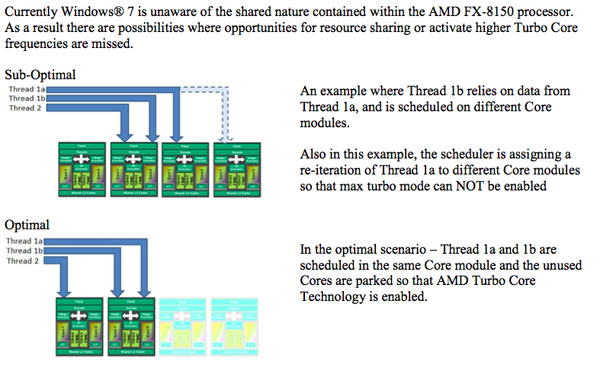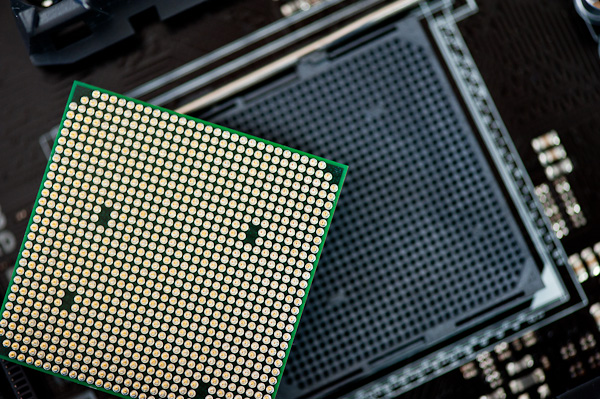The Bulldozer Review: AMD FX-8150 Tested
by Anand Lal Shimpi on October 12, 2011 1:27 AM ESTFinal Words
In many cases, AMD's FX-8150 is able to close the gap between the Phenom II X6 and Intel's Core i5 2500K. Given the right workload, Bulldozer is actually able to hang with Intel's fastest Sandy Bridge parts. We finally have a high-end AMD CPU with power gating as well as a very functional Turbo Core mode. Unfortunately the same complaints we've had about AMD's processors over the past few years still apply here today: in lightly threaded scenarios, Bulldozer simply does not perform. To make matters worse, in some heavily threaded applications the improvement over the previous generation Phenom II X6 simply isn't enough to justify an upgrade for existing AM3+ platform owners. AMD has released a part that is generally more competitive than its predecessor, but not consistently so. AMD also makes you choose between good single or good multithreaded performance, a tradeoff that we honestly shouldn't have to make in the era of power gating and turbo cores.
Bulldozer is an interesting architecture for sure, but I'm not sure it's quite ready for prime time. AMD clearly needed higher clocks to really make Bulldozer shine and for whatever reason it was unable to attain that. With Piledriver due out next year, boasting at least 10-15% performance gains at the core level it seems to me that AMD plans to aggressively address the shortcomings of this architecture. My only concern is whether or not a 15% improvement at the core level will be enough to close some of the gaps we've seen here today. Single threaded performance is my biggest concern, and compared to Sandy Bridge there's a good 40-50% advantage the i5 2500K enjoys over the FX-8150. My hope is that future derivatives of the FX processor (perhaps based on Piledriver) will boast much more aggressive Turbo Core frequencies, which would do wonders at eating into that advantage.

AMD also shared with us that Windows 7 isn't really all that optimized for Bulldozer. Given AMD's unique multi-core module architecture, the OS scheduler needs to know when to place threads on a single module (with shared caches) vs. on separate modules with dedicated caches. Windows 7's scheduler isn't aware of Bulldozer's architecture and as a result sort of places threads wherever it sees fit, regardless of optimal placement. Windows 8 is expected to correct this, however given the short lead time on Bulldozer reviews we weren't able to do much experimenting with Windows 8 performance on the platform. There's also the fact that Windows 8 isn't expected out until the end of next year, at which point we'll likely see an upgraded successor to Bulldozer.

So what do you do if you're buying today? If you have an existing high-end Phenom II system, particularly an X4 970 or above or an X6 of any sort, I honestly don't see much of a reason to upgrade. You're likely better off waiting for the next (and final) iteration of the AM3+ lineup if you want to stick with your current platform. If you're considering buying new, I feel like the 2500K is a better overall part. You get more predictable performance across the board regardless of application type or workload mix, and you do get features like Quick Sync. In many ways, where Bulldozer is a clear win is where AMD has always done well: heavily threaded applications. If you're predominantly running well threaded workloads, Bulldozer will typically give you performance somewhere around or above Intel's 2500K.
I was hoping for Bulldozer to address AMD's weakness rather than continue to just focus on its strengths. I suspect this architecture will do quite well in the server space, but for client computing we may have to wait a bit longer for a more competitive part from AMD. The true culprit for Bulldozer's lackluster single-threaded performance is difficult to track down. The easy answer would seem to be clock speed. We've heard of issues at Global Foundries and perhaps Bulldozer is the latest victim. If AMD's clock targets were 30% higher than Phenom II, it simply didn't make them with the FX-8150. I've heard future derivatives will focus more on increasing IPC indepedent of process technology and clock speed, but if you asked me what was the one limit to success I would say clock speed. As a secondary factor, AMD appeared to make some tradeoffs to maintain a reasonable die size at 32nm. Even then Bulldozer can hardly be considered svelte. I suspect as AMD is able to transition to smaller transistor geometries, it will be able to address some of Bulldozer's physical shortcomings.
The good news is AMD has a very aggressive roadmap ahead of itself; here's hoping it will be able to execute against it. We all need AMD to succeed. We've seen what happens without a strong AMD as a competitor. We get processors that are artificially limited and severe restrictions on overclocking, particularly at the value end of the segment. We're denied choice simply because there's no other alternative. I don't believe Bulldozer is a strong enough alternative to force Intel back into an ultra competitive mode, but we absolutely need it to be that. I have faith that AMD can pull it off, but there's still a lot of progress that needs to be made. AMD can't simply rely on its GPU architecture superiority to sell APUs; it needs to ramp on the x86 side as well—more specifically, AMD needs better single threaded performance. Bulldozer didn't deliver that, and I'm worried that Piledriver alone won't be enough. But if AMD can stick to a yearly cadence and execute well with each iteration, there's hope. It's no longer a question of whether AMD will return to the days of the Athlon 64, it simply must. Otherwise you can kiss choice goodbye.











430 Comments
View All Comments
silverblue - Monday, October 17, 2011 - link
The reason for mentioning the 2600 is because that's the only comparison we have for the moment. I don't expect Valencia to use as much power as Zambezi even on a clock-for-clock basis.Pipperox - Monday, October 17, 2011 - link
That has to be seen.Bulldozer's HUGE 16MB of total cache surely were not put there for desktop workloads.
xineis - Sunday, October 16, 2011 - link
I am quite disappointed with the overall performance. And specially with gaming performance.But what about that rumored patch fix for the BDZ? Has any of you guys at AnandTech heard of that?
silverblue - Sunday, October 16, 2011 - link
You mean this one?http://quinetiam.com/?p=2356
Interesting if it's true, however it's doubtful to help across the board (pun not intended). Still, very good news for those doing rendering/encoding.
richaron - Sunday, October 16, 2011 - link
I never want to see a link to that dickbag again..His blogs about WW3, bigfoot, & 2012 should be enough to give you an idea. Also, the dudes at Kubuntu basically do repackaging & KDE integration. They don't touch hardware.
No doubt there can be significant gains through software. But I would rather stab myself through the eyelid than read anything more by that 'person'.
xineis - Sunday, October 16, 2011 - link
Yeah, that one. I know that there is a very slim chance of that 40% boost ever happening, but the idea behind the "patch" is actually plausible.I've seen lots of people explaning how would it work and it looks somewaht legit.
Granted that 40% is too much, but if the right tweaking, I'd be more than happy with 20% to 30% increase in performance!
richaron - Monday, October 17, 2011 - link
everyone would be happy with 20-30%. It doesn't seem realistic to me... but i dropped out of computer engineering :pFrom what I've seen, I would guess about 5% [+/- 5%]
silverblue - Monday, October 17, 2011 - link
Turns out he was one giant troll, or seemingly so. Now, he's pointing the finger at..."Problem solved, it’s just a thermal protection issue, people have been pushing voltages too high. Maybe there’s some variance in mainboard chipsets, but some overclockers and hitting really good numbers."
Really? After all that hoo-har about registry patches, BIOS flashes and the like, we're now blaming thermal protection? I'm taking this with a litre of Dead Sea water.
silverblue - Monday, October 17, 2011 - link
Hey, there has to be somebody somewhere that we can all laugh at. ;)That said, he does sound a bit... odd.
Romulous - Monday, October 17, 2011 - link
perhaps Bulldozer.Next will actually work ;)